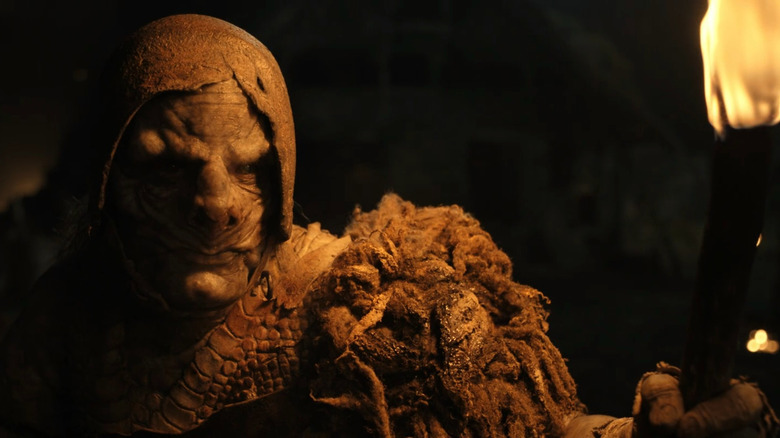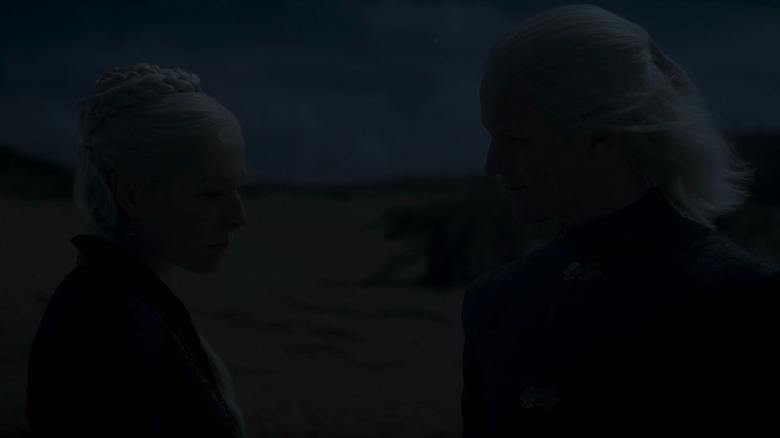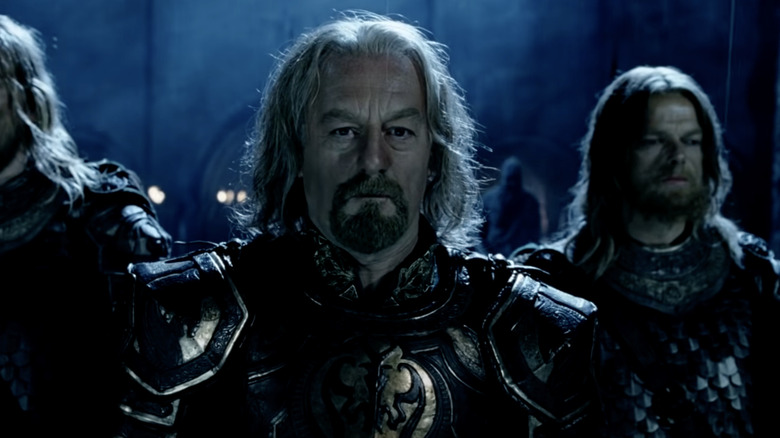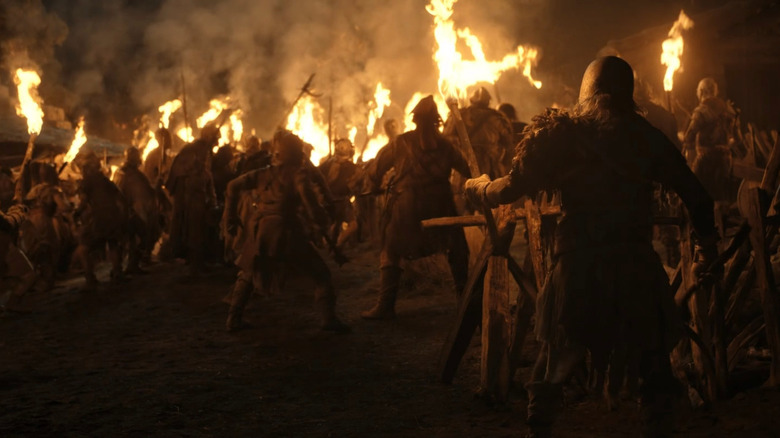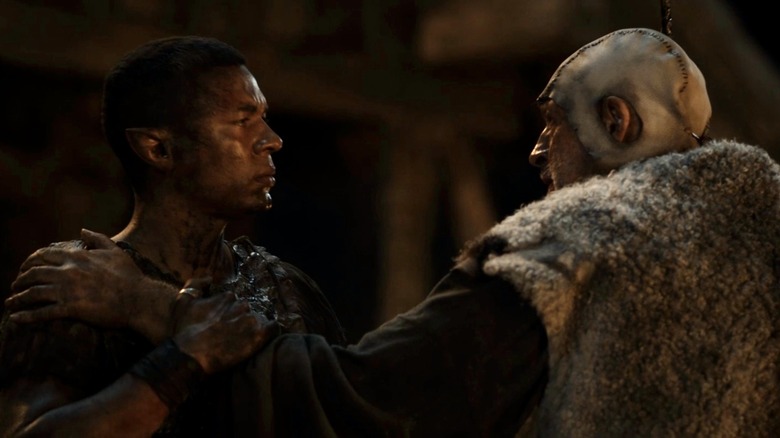The Lesson The Rings Of Power Learned From Game Of Thrones
"House of the Dragon" and "The Lord of the Rings: The Rings of Power" continued their parallel prestige fantasy ride this last weekend, each with an episode that — dramatically, at least — may well be the best the series has delivered thus far. "Driftmark" and "Udûn," respectively the seventh and sixth episode of "House of the Dragon" and "The Rings of Power," were full of unbearably tense confrontations and fights where long-simmering plotlines came to a head in an explosive manner.
Yet on Monday morning, in the immediate aftermath of "House of the Dragon" the night before, it seemed like all anyone could talk about in the Bad Place (meaning, social media) was how dark the beach scenes in "Driftmark" were. If you're like me, your timeline may have been flooded with all-black screenshots and complaints of how hard it was to visually decipher those scenes.
/Film's Mike Shutt has explored why "Driftmark" looks the way it does. In a nutshell, it was a creative choice made by the episode's director and cinematographer, Miguel Sapochnik and Fabian Wagner, who prefer practical lighting (whereby only natural light sources are used) and were shooting day for night in this case, having previously faced a difficult shoot on the "Game of Thrones" episode, "The Long Night" (which actually was shot at night).
At the same time, all this fuss and furor serves to illuminate (lighting pun intended) just how well done "Udûn" and its night scenes were. "The Rings of Power" seems to have learned a valuable lesson from "Game of Thrones" and its much-derided Battle of Winterfell in "The Long Night." Or maybe it's just keeping up its own franchise legacy from the Battle of Helm's Deep in "The Lord of the Rings: The Two Towers."
Lighting by Chuck McGill?
Debates over the darkness of lighting in movie and TV shows are nothing new, of course. Back in 2016, Slate ran a report, "Why TV Shows Are Darker Than They've Ever Been," detailing changes in the approach to lighting from "I Love Lucy" to "The Sopranos." One of the shows mentioned in there was "Better Call Saul," which just concluded its final season over the summer.
"Better Call Saul" had a whole subplot where a character, Chuck McGill (Michael McKean), who claimed to suffer from electromagnetic hypersensitivity (EHS), was always sitting around his house with the lights off and a space blanket over his head. Yet that spilled over into scenes of other characters without EHS sitting in dark rooms, as the series drew from a noir sensibility to tell its story. Fewer complaints arose about the lighting of "Better Call Saul" because, even with the lights off in-scene, you could usually make out what was happening.
Two other examples from 2022 of well-received movies with low-lit scenes are "The Batman" and "Nope." It's undeniable that moody dark lighting has become more of a tool in the cinematographer's kit, and that isn't always a bad thing. But there are definitely times when it's downright annoying and seems to add nothing but frustration to the viewing experience, as if you were watching a production lit by Chuck McGill.
As a viewer, I know I've personally developed a pet peeve that some of our readers might share: namely, when something I'm ostensibly "watching" (or trying to, anyway) is seemingly under-lit insofar as you can't see anything. It's the kind of thing where, while at-home viewing more during the pandemic, I've often found myself having to turn up the brightness on my screen, even with the motion smoothing off.
The night in Middle-earth: Not so dark, after all
Turning up the brightness all the way obviously isn't an option when you're in the theater, but for what it's worth, I did it with "Driftmark" and it solved the issue enough to where I could track the House Targaryen actors' platinum-blonde silhouettes on the beach better. It's not necessarily ideal, though, to put the onus on the viewer to adjust the brightness, dim the lights, and/or buy a better TV just so they're not having to squint through the dark at your show.
This is why people were so up in arms in 2019 about "The Long Night," which more than lived up to its dark-sounding name. By way of a refresher: this was the "Game of Thrones" episode where, after building up the threat of the White Walkers the whole series, they finally attacked Winterfell. There was all this expectation behind it, and some viewers weren't happy with the resulting meal of murky fighting forms and dark images during a battle that was supposed to serve as an epic climax. Cinematographer Fabian Wagner defended the choice of the episode's lighting, and there are different sides to the argument in general. Some people may love the truthfulness of low-lit realism.
Which brings us back to "Udûn." Part of what makes this new episode of "The Rings of Power" so refreshing to watch is that you can actually see what's happening, even during the nighttime battle. Elsewhere, I've joked that Middle-earth — much like Westeros on "Game of Thrones" — "is dark and full of terrors." This was more a euphemism for "Udûn" upping the violence quotient, because the episode's actual lighting allows us to see what is going on in a way that its fantasy forebear, "The Long Night," didn't.
The Rings of Power carries the fire
"Udûn," which is directed by Charlotte Brändström and shot by Alex Disenhof, circumvents the usual complaints about how we can't see anything during night scenes by having an army of orcs carry torches into the village it attacks. The episode is still dark in places, but as "Lord of the Rings" star Viggo Mortensen might say in "The Road:" it's carrying the fire. Because there are torches and fires burning all around, we're able to get a better visual lock on things and get better invested in the life-or-death stakes of the village battle, same as we were invested in the blue-tinged Battle of Helm's Deep in "The Lord of the Rings: The Two Towers."
In Helm's Deep, it's night and it's raining, but the character's faces are lit clearly and there are also lightning flashes to help illuminate the battle. Andrew Lesnie's cinematography is a masterpiece of lucidity by today's standards. Sure, it's stylized: it wouldn't really be that well-lit in real life. But newsflash, Hollywood: fantasy creatures like orcs don't exist in real life, either. It feels like, if Helm's Deep were shot now, it would be 10 times darker than it was 20 years ago in Peter Jackson's film.
There's a part in "The Two Towers" where the dwarf Gimli (John Rhys-Davies) is trying to crane his neck over the Helm's Deep wall, and he asks, "What's happening out there?" The elf Legolas retorts, "Shall I describe it to you?" He might just as well be snarking on any number of other movies or shows where the viewer can't see things clearly and would almost need the director or cinematographer to describe what they saw on their monitors before they put their work out into the world.
Communicating with the audience effectively
The darkness issue is something that pops up to one degree or another even in films and television shows I enjoy, and "House of the Dragon" remains one of those. Your mileage may vary, but the beach scenes in "Driftmark" didn't ruin the episode for me. As Variety alludes, it makes a certain sort of sense for fantasy scenes that are reliant on makeup and visual effects to go dark as a way of masking or minimizing the eye's exploration and rejection of the uncanny valley onscreen.
Having said that, this new episode of "House of the Dragon" is part of a larger overall trend in entertainment, one that would almost be worthy of another investigation like the one /Film's Ben Pearson did late last year about why movie dialogue has gotten more difficult to understand. Digital color correction has opened up a new frontier for low-lit scenes in Hollywood, but if the viewer can't hear what is being said or see what is being shown, it's only going to distract from the story you're trying to tell.
Film and television is an art, but it's not just about self-expression on the part of creative people. Rather, it's about communication with the audience through a visual medium. On that score, "Udûn" and "The Two Towers" communicate much more effectively than "Driftmark" or "The Long Night" did.
As Valerie Ettenhofer writes, "The Rings of Power" is "the antithesis to the literally dark fantasy show." Since we're practically living in the post-apocalypse now, anyway, maybe more directors and cinematographers should take a lesson from "The Road" and "The Rings of Power" and start carrying the fire.
